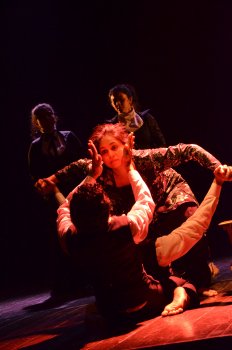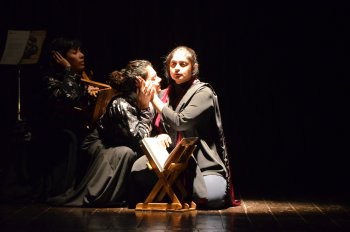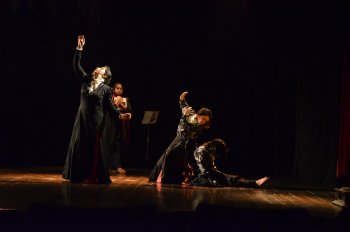
|   |

|   |
Music and deafness - Sulagna Mukhopadhyay, Kolkata e-mail: sulagna64@gmail.com Photos: Sajal Ghosh March 12, 2013 Choreographing a dance performance on the different music pieces of Beethoven is not an easy task. But choreographer Vikram Iyenger of Ranan did it with élan. His script was based on the letters written by Beethoven to his brothers and the novel An Equal Music by Vikram Seth. The premiere was on 1st March 2013 at the auditorium of Max Mueller Bhavan, Kolkata.  Das Heiligenstaedter Testament or The Heiligenstadt Testament was a letter written by Ludwig van Beethoven on October 6, 1802 in Heiligenstadt, a suburb near Vienna. The testament was addressed to his brothers Karl and Johann. It was quite a strange thing that though it was written to both the brothers, the name of Johann never appeared on the Testament, instead there was a blank space. It was clearly mentioned that it was “to be read and executed after my death.” The year 1802 marked the highest point of Beethoven’s crisis. He fell in love with Giullieta Guicciardi, which was reciprocated but with the end of the year, their relationship also ends. Beethoven enters into a world of depression. Gradually his strong character overcomes both his physical and mental states and he gives shape to the Testament. He composes one of his major pieces, Symphony No. 3 in flat E Major, Op. 55, which he later named Eroica. It was composed to show honour to Napoleon Bonaparte. This Testament was discovered in March 1827 by Anton Schindler and Stephan von Breuning after Beethoven’s death. Seth was inspired by John Donne’s sermons “.... but one equal music”, where Donne describes life after death and uses it as his epigraph. The protagonist in the novel Michael Holme is a violinist based in London. He is a member of the Maggiore Quartet. The novel An Equal Music showcases Michael’s love for Julia McNicholl, with whom he studied music in Vienna but left her to flee from his autocratic music teacher. Ten years later he meets Julia who is by then married with a child. Michael realises that Julia is gradually deafened by an auto-immune disease. Vikram Seth in the process of his writing indulges in the works of Beethoven, Bach, Mozart and Hayden. Based on the identical agonies and frustrations of the two characters Beethoven and Julia McNicholl, Vikram Iyenger named his choreographic piece THOSE WHO COULD NOT hear the music. He has resorted to dance-theatre form. A well-done research on Beethoven is projected in this piece. Vikram has read books like Memories of Beethoven, Beethoven: The Composer as Hero, Beethoven and Friends to describe the character of the music maestro. Vikram Iyenger deviates from the original novel of Vikram Seth and sets Julia as the protagonist in place of Michael. Her illness, her love for music and her mistrust in Michael are interwoven neatly. Finally, Julia sets herself free from the love of Michael and accepts her fate. Realising that Beethoven and she herself are bound together by an inextricable fate, Julia seeks to Beethoven’s music pieces to continue living. 

The show begins with Piano Concerto# 3 in C Minor, Op. 37 -- Allegro con brio and Vikram as the music conductor Beethoven. One corner of the stage is occupied by Julia and the other by Amlan Chaudhuri, who characterised Beethoven through excerpts taken from The Heiligenstadt Testament. The Piano Concerto phases out with the famous words, “Oh you men who think or say that I am malevolent, stubborn, or misanthropic, how greatly do you wrong me? You do not know the secret cause which makes me seem that way to you. .... But, think that for six years now I have been hopelessly afflicted, made worse by senseless physicians, from year to year deceived with hopes of improvement, finally compelled to face the prospect of a lasting malady (whose cure will take years or, perhaps, be impossible). Though born with a fiery, active temperament, even susceptible to the diversions of society, I was soon compelled to withdraw myself, to live life alone.” Julia earnestly tries to listen to a piece by Beethoven, putting her ear quite close to the player and breaks down when she realises her shortcoming. Vikram has conceptualised and dealt with the theme uniquely. While the character of Beethoven is portrayed by him through dance and Amlan through dialogues, the character of Julia is depicted in dance by Debashree, Rhea and Sohni and through discourses by Anubha Fatehpuria. Using the stool as the cross, which symbolised the acceptance of Fate as that of Christ, was mesmerizing. Blessed with unerring musicality and keenly deployed technique, Vikram successfully balanced between dialogues, mimes and movements. Kathak exponents like Debashree Bhattacharya, Jayati Chakraborty, Rhea Das, Sohini Debnath along with Vikram himself have worked hard. There was a dazzling display of rhythmic complexity, pirouettes, exquisitely detailed hand movements and other technical virtuosity. Equally efficient were the actors. The costume was well-thought by Katy Lai Roy. The props used were apt. Despite all endeavours, the character of the music teacher was non-conforming and the audience was of the opinion that the show should end with Beethoven’s 9th Symphony. Sulagna Mukhopadhyay was trained in Bharatanatyam by Guru Thankamani Kutty and Indian folk by Late Botu Pal. She has an M.A. in Comparative Literature and has freelanced for various leading newspapers of Kolkata like The Telegraph, The Statesman and Ananda Bazar Patrika. She has written articles on dance and gender issues. She is a teacher of South Point School since 1996. |